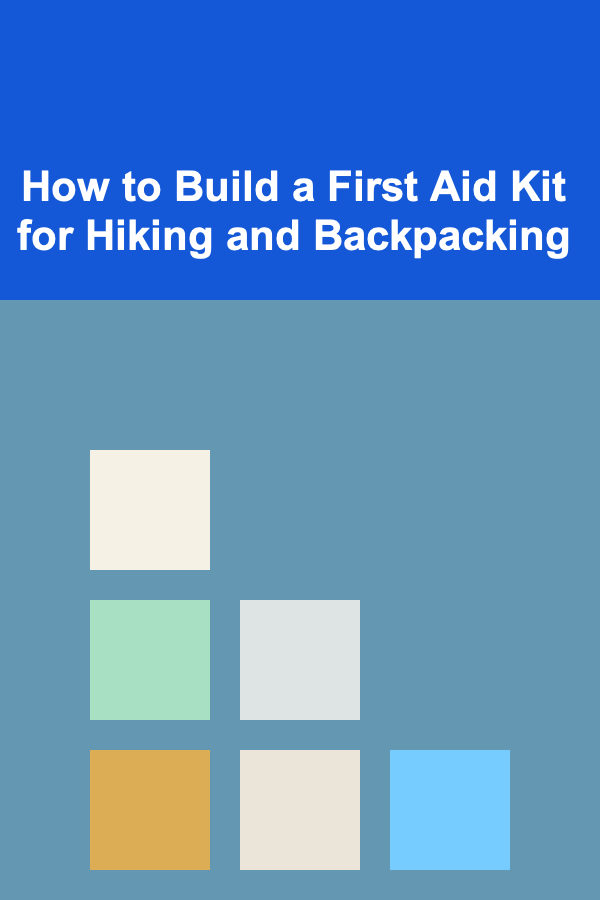
How to Build a First Aid Kit for Hiking and Backpacking
ebook include PDF & Audio bundle (Micro Guide)
$12.99$10.99
Limited Time Offer! Order within the next:

When you venture into the wilderness for a hike or backpacking trip, safety is paramount. One of the most essential items you should pack is a well-organized first aid kit. Accidents can happen at any time---whether it's a twisted ankle, a scraped knee, or a more severe injury. Having a comprehensive first aid kit will give you the tools to address minor injuries and even provide temporary assistance until professional help can be reached if needed.
In this article, we'll explore the key elements you should include in your first aid kit for hiking and backpacking. By the end, you'll know how to assemble a kit that is compact, lightweight, and capable of handling a variety of potential emergencies.
Assess Your Needs Based on the Environment
The first step in building your first aid kit is understanding the environment in which you'll be hiking or backpacking. The terrain, climate, and expected weather conditions all play a role in determining what supplies you need. For example, if you're heading into a remote wilderness area, you might need to include additional supplies for treating more serious injuries or handling environmental conditions like extreme heat or cold.
Factors to Consider:
- Location: Are you hiking in mountainous terrain, forests, deserts, or coastal regions?
- Weather: Will it be cold, hot, or wet? The conditions will affect what items you'll need.
- Group Size: Are you hiking solo or with a group? More people require more supplies.
- Duration of Trip: A day hike may require fewer items than a multi-day backpacking trip.
Once you have a clear understanding of the environment and the potential risks involved, you can begin selecting the appropriate components for your first aid kit.
Basic Medical Supplies
Your first aid kit should contain the basic supplies necessary for dealing with minor injuries such as cuts, scrapes, blisters, and burns. These supplies are lightweight and compact, making them perfect for outdoor adventures.
Essential Items:
- Adhesive Bandages (Various Sizes): These are essential for covering small cuts, blisters, or abrasions. Having a variety of sizes ensures that you can treat any type of wound.
- Sterile Gauze Pads: Useful for cleaning and covering larger wounds or cuts to help stop bleeding.
- Adhesive Tape: Use this to secure gauze pads or bandages in place.
- Antiseptic Wipes: Perfect for cleaning wounds before applying bandages to prevent infection.
- Antibiotic Ointment: Apply this to cuts and scrapes to reduce the risk of infection.
- Burn Cream or Gel: If you're hiking in areas with potential for sunburns or exposure to hot surfaces, this will soothe burns.
- Alcohol Pads: These can be used to disinfect your skin, tools, or any instruments you need to use.
- Cotton Swabs: Handy for applying ointments and cleaning smaller wounds.
Pain Relief and Medications
Pain relief is crucial, especially when you're far from medical help. Whether it's from an injury or just general discomfort, the right medications can make your hike more enjoyable and manageable.
Recommended Medications:
- Ibuprofen or Acetaminophen: These over-the-counter medications are essential for pain relief and reducing inflammation. Ibuprofen is especially useful for swelling or muscle aches, while acetaminophen is gentler on the stomach.
- Aspirin: An alternative for pain relief or for use in treating chest pain (in case of heart issues). It's important to be aware of any personal allergies to aspirin before bringing it.
- Antihistamines (Benadryl or similar): In case of allergic reactions from insect stings, bee bites, or plants, antihistamines can provide relief.
- Anti-Diarrhea Medication: Diarrhea can be a significant issue, especially if you're far from clean water sources. Having an anti-diarrheal like Imodium is a good precaution.
- Electrolyte Tablets: These help replenish salts and minerals lost through sweat, preventing dehydration and muscle cramps.
Injury and Trauma Management
Accidents can occur that are more serious than scrapes and bruises. You should be prepared for scenarios like sprains, fractures, or even hypothermia in cold conditions. The following supplies will help manage such injuries.
Key Items for Trauma:
- Elastic Bandage (e.g., Ace Bandage): This is useful for sprains, strains, and swelling.
- Splints: A lightweight splint (or a few popsicle sticks) can help immobilize broken limbs.
- Cold Pack: An instant cold pack is perfect for reducing swelling and pain from sprains, strains, or blunt force trauma.
- Thermal Blanket: Lightweight and compact, a thermal or space blanket retains body heat in emergencies, especially if you are caught in cold weather.
- Tweezers: Useful for removing splinters, ticks, or insect stingers.
- Scissors: Small, sharp scissors will help cut tape, gauze, or clothing when needed.
- Instant Heat Pack: Ideal for warming up cold hands, feet, or for use in cold weather-related injuries like frostbite.
Wound and Infection Prevention
Keeping wounds clean and preventing infection is critical, especially when you're out in nature. The environment can expose you to bacteria and other harmful microorganisms, making it essential to have the right supplies to prevent infections.
Infection Control Supplies:
- Antiseptic Cream: Along with wipes, antibiotic ointment can help prevent infections in small wounds.
- Hydrocortisone Cream: This can reduce irritation from insect bites, rashes, or other allergic skin reactions.
- Sterile Gloves: Protect yourself and others when treating injuries to avoid contamination.
- Burn Dressings: If you're hiking in areas prone to sunburns, a burn dressing can help soothe and protect burned skin.
Insect and Animal Protection
Hiking in nature exposes you to a variety of insects and animals. These can range from harmless to potentially dangerous, so it's important to take preventive measures.
Insect and Animal Protection:
- Insect Repellent: A strong insect repellent, preferably with DEET, will protect you from mosquitoes and ticks that can transmit diseases like Lyme disease.
- Tick Removal Tool: If you find a tick on your skin, you'll want to remove it carefully to reduce the risk of infection.
- Snake Bite Kit: While rare, snake bites are a possibility in some areas. A snake bite kit can help provide immediate care until medical help arrives.
- Anti-venom (if needed): In some cases, carrying a basic anti-venom is a good idea if you're hiking in areas known for venomous animals.
Specialized Items for Longer or Remote Trips
If you're venturing on a multi-day backpacking trip, or if you'll be in a particularly remote area, you might need additional specialized items in your first aid kit. These supplies can help with long-term injuries or conditions that may arise during extended stays in the wilderness.
Additional Items for Remote Areas:
- Water Purification Tablets or Filter: Clean water is crucial to preventing illnesses, and a portable water purifier ensures you'll have access to safe drinking water.
- Stitches Kit: If you're familiar with how to use them, a stitch kit can help you close larger wounds until you can get medical help.
- Personal Medications: If you have any ongoing health conditions, make sure to bring an adequate supply of your prescription medications, along with a copy of the prescription.
Packing and Organizing Your First Aid Kit
The final step is packing your first aid kit in a way that ensures everything is easily accessible and organized. A well-organized kit will save valuable time in an emergency, allowing you to quickly find the items you need.
Packing Tips:
- Use a Waterproof Bag: Choose a waterproof, durable bag to protect your supplies from rain or water damage.
- Separate Items by Category: Use small pouches or zip-lock bags to keep similar items together. For example, keep bandages in one bag and medications in another.
- Label Everything: Label all medications, ointments, and supplies to prevent confusion.
- Compactness: Choose a kit that is compact but holds all the necessary items. Ensure that the kit is lightweight to avoid unnecessary weight in your pack.
Training and Knowledge
Building a first aid kit is only part of the equation. Knowing how to use the supplies in your kit and understanding basic first aid is essential. Taking a wilderness first aid course is an excellent way to learn essential skills such as CPR, how to handle fractures, and how to treat various injuries.
Conclusion
Having a well-stocked first aid kit can make all the difference in ensuring your safety and well-being during a hiking or backpacking trip. By carefully selecting the right supplies and organizing your kit efficiently, you'll be prepared to handle minor injuries and medical emergencies. Always remember, however, that the best way to avoid injury is to hike with caution, stay aware of your surroundings, and respect the environment.
Reading More From Our Other Websites
- [Organization Tip 101] How to Use Furniture as Storage in Small Spaces
- [Home Staging 101] How to Stage for a Faster Sale: The Ultimate Guide to Home Staging for a Faster Sale
- [Stamp Making Tip 101] Best Eco‑Friendly Materials for Crafting Handmade Self‑Ink Stamps
- [Personal Investment 101] Exploring Passive Income Ideas with Deep Learning Models
- [Gardening 101] The Best Flowers for Your Flower Garden in Every Season
- [Organization Tip 101] How to Use Color Coding for Home Inventory Categories
- [Personal Investment 101] How to Navigate Cryptocurrency Investing: A Beginner's Guide
- [Home Security 101] How to Secure Your Wi-Fi Network for Home Security
- [Digital Decluttering Tip 101] From Screen Fatigue to Mindful Living: Why a Digital Detox Matters
- [Home Cleaning 101] How to Keep Your Bathroom Spotless Every Day

How to Build a Travel Photography Website to Showcase Your Work
Read More
How to Minimize the Appearance of Dark Spots on Hands
Read More
How to Save Money on Home Improvement Supplies
Read More
How to Turn Deep Learning into a Steady Income Stream
Read More
How to Use Dollar-Cost Averaging to Lower Investment Risk
Read More
Choosing the Perfect Sleeping Bag for Your Adventures
Read MoreOther Products

How to Build a Travel Photography Website to Showcase Your Work
Read More
How to Minimize the Appearance of Dark Spots on Hands
Read More
How to Save Money on Home Improvement Supplies
Read More
How to Turn Deep Learning into a Steady Income Stream
Read More
How to Use Dollar-Cost Averaging to Lower Investment Risk
Read More